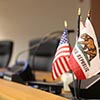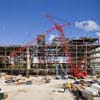Legal "Round-up": Sexual Orientation and Gender Identity in the Education World

Number 44
The United States Supreme Court recently held that all states are required to license same-sex marriages and recognize same-sex marriages validly performed out of state. (Obergefell, et al. v. Hodges, (June 26, 2015) 2015 U.S. Lexis 4250.) While monumental on a national level, this ruling is just the latest event in the rapidly changing legal landscape relating to issues of sexual orientation and gender identity. These issues are commonly described as affecting individuals who are lesbian, gay, bisexual, and transgender (LGBT).
School and college districts face unique challenges when incorporating legal and societal changes into their day-to-day operations that involve two separate groups: the students they serve and the individuals they employ. To assist county offices of education, school and college districts, and charter schools in staying up-to-date, a synopsis of recent legal developments related to both students and employees is provided below. The following are key terms at the center of this discourse. The definitions provided are based on definitions available through legal and advocacy resources, the field of psychology, and general common usage:
- "Sexual orientation" refers to heterosexuality, homosexuality, and bisexuality and means the emotional and sexual attraction to another person based upon gender.
- "Gender" means a person's sex and includes gender identity and gender expression.
- "Gender identity" means an individual's sense of being masculine, feminine, both or neither, regardless of one's biological sex or assigned sex at birth. Gender identity is not necessarily observable or exhibited through gender expression or sexual orientation.
- "Gender expression" means a person's gender-related appearance and behavior whether or not associated with the person's assigned sex at birth.
- "Transgender" is an umbrella term describing an individual whose gender identity and/or expression is different from their biological sex and the way in which males or females are commonly expected to present themselves.
LGBT Issues in the Employment Context
Legal protections related to sexual orientation and gender identity are contained in state and federal laws addressing nondiscrimination and harassment. Title VII of the Civil Rights Act of 1964, a federal law, prohibits discrimination on the basis of sex. Courts and the Equal Employment Opportunities Commission, the federal agency responsible for enforcement of Title VII, have held that discrimination against an individual on the basis of non-conforming gender identity and sex-stereotyping is discrimination on the basis of sex. California state law, through the Fair Employment and Housing Act ("FEHA"; Gov. Code § 12940, et seq.) goes a step further and specifically includes sexual orientation, gender identity, and gender expression as protected classes of their own, in addition to sex and gender generally.
Under both state and federal law, health benefits must be available to same-sex spouses on the same basis as that provided to opposite-sex spouses.
LGBT Issues in the Education Context
California law provides protections against discrimination based upon sexual orientation, gender, gender identity, and gender expression in the education-related context, as set forth in Education Code section 220. California law also requires school districts to adopt policies prohibiting discrimination, harassment, intimidation, and bullying on the basis of these characteristics, and the overall legislative focus on bullying issues has been growing over the past several years. (Ed. Code § 234.1.) Further, federal law under Title IX of the Education Amendments of 1972 requires school districts to adopt and distribute a policy that they will not discriminate on the basis of sex in their education programs and activities. School districts, and in some cases school officials, may be held liable for their willful failure to address behavior in violation of these requirements. The sex discrimination provisions of Title IX have been read by courts to include discrimination against homosexual students. The U.S. Department of Education's Office for Civil Rights (OCR) has increasingly attempted to extend rights to students based on their gender identity by treating gender identity as a sex-based protection, even though federal law does not expressly identify sexual orientation, gender identity, or gender expression as protected classifications.
As of 2014, school districts in California must allow a student to participate in sex-segregated school programs and activities, and use facilities, consistent with the student's gender identity regardless of the student's biological sex. (Ed. Code § 221.5.) Importantly, Section 221.5 does not allow a school district to require transgender students to use neutral or separate facilities, such as restrooms or locker rooms. Further, there is no legal guidance regarding how a district determines a student's gender identity, or how the privacy and religious rights of other students and their parents should be accommodated in the use of private spaces. While not binding, OCR has also made it clear that it interprets Title IX to require similar access and accommodations for transgender students. Even though there is no current statute related to the use of facilities by transgender employees, a school district would arguably violate FEHA's non-discrimination provisions by limiting a transgender employee's use of facilities, such as restrooms, based upon the employee's biological sex. Additionally, the Title VII issues related to employees discussed in the section above are also implicated and should be considered. Beyond these legal access issues, California Interscholastic Federation (CIF) bylaws regarding eligibility were amended in 2013 to provide that students may participate in CIF activities in a manner that is consistent with their gender identity, irrespective of the gender listed on a student's records.
Changes in the law relating to LGBT issues also affect the educational curriculum. Under California law, school curricula must include references to the contributions of lesbian, gay, bisexual, and transgender Americans, among other groups, when teaching about the economic, political, and social development of California and the United States. (Ed. Code § 51204.5.) School districts are also prohibited from adopting instructional materials that reflect adversely upon groups identified in Section 220 of the Education Code, including LGBT persons. (Ed. Code §§ 51501, 60040, 60044.)
Finally, school districts are required to provide access to student groups on a content-neutral basis. If a public secondary school allows at least one student group that is not curriculum-related to meet on school premises during non-instructional time, it has created a "limited open forum," and the school must provide equal access to all non-curricular student clubs, including gay-straight alliance clubs. "Access" would include meeting spaces, visible recognition, and the privileges afforded to other student groups.
Public schools are affected by the developing law on LGBT issues and it is important for school districts to stay abreast of the rapidly changing legal environment. Knowledge of these laws will protect a school district's employees and students from discrimination, and can help school districts avoid unintended legal liabilities.
If you have any questions regarding the topics discussed above or regarding whether your existing policies or regulations are compliant with the requirements discussed above, please contact one of our nine offices located statewide. You can also visit our website, follow us on Facebook or Twitter, or download our Client News Brief App.
As the information contained herein is necessarily general, its application to a particular set of facts and circumstances may vary. For this reason, this News Brief does not constitute legal advice. We recommend that you consult with your counsel prior to acting on the information contained herein.






